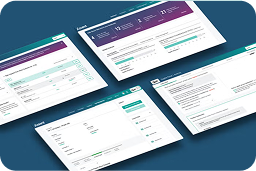On September 24, 2025, the California Air Resources Board (CARB) published its preliminary list of entities that may be subject to Senate Bill (SB) 261 California climate risk reporting and SB 253 Greenhouse Gas (GHG) emissions reporting. The move marks a major step toward implementing California’s climate disclosure laws, which will reshape the expectations for companies doing business in the state.
For risk managers and compliance professionals, this is more than a California story. It’s part of a broader global push toward mandatory climate and sustainability disclosures. The time to prepare is now.
What Are the SB 261 Requirements?
California SB 261 applies to companies that are defined as a corporation, partnership, limited liability company, or other business entity with total annual revenues above $500 million and doing business in California. It obligates covered companies to publish a climate-related financial risk report every two years, beginning in 2026. The report must:
- Describe material climate-related financial risks
- Explain how the company identifies, assesses, and manages those risks
- Align with the framework developed by the Task Force on Climate-related Financial Disclosures (TCFD) or an equivalent standard
SB 261 compliance is about demonstrating resilience: showing investors, regulators, and customers that your company is prepared for the financial realities of a changing climate.
CARB’s Preliminary Entity List
CARB’s September 24 release included a preliminary list of roughly 4,150 entities that may fall under SB 261 and SB 253. Here are some important details about the list:
- It’s preliminary. CARB acknowledges that the list includes duplicates and inconsistencies, especially when matching company names across datasets
- It’s not complete. The list is based on Secretary of State records active as of March 2022, so some in-scope companies may be missing
- It doesn’t cover exemptions. Potential carve-outs discussed at CARB’s August 2025 workshop are not yet reflected
- It doesn’t determine liability. Companies may be responsible for compliance even if they don’t appear on this version of the list
The purpose of the list is to support the development of CARB’s fee regulation, not to serve as a final compliance roster.
Stakeholder Feedback: Your Chance to Weigh In
CARB has launched a voluntary survey to help validate its data and receive stakeholder feedback. Companies that believe they may be subject to SB 261 — or that may qualify for an exemption — are encouraged to participate.
Access the CARB stakeholder survey here.
This is an opportunity to share feedback about the preliminary list before fee structures and compliance expectations are finalized.
How SB 261 Intersects With SB 253
While SB 253 requires companies to disclose their greenhouse gas (GHG) emissions, SB 261 requires them to report on climate-related financial risk. Many companies will be subject to both laws, but not all.
- SB 253 (California GHG): Annual disclosure of Scope 1, 2 (starting in 2026), and 3 GHG emissions (starting in 2027), subject to third-party assurance
- SB 261 California: Biennial disclosure of climate-related financial risk and management strategies
These two laws together create a dual reporting obligation: emissions data on one side, risk governance and disclosure on the other.
What Compliance & Sustainability Professionals Should Do Now
- Confirm your status: Review CARB’s preliminary list and determine whether your company may be in scope of SB 261 California, SB 253, or both.
- Engage with CARB: Use the voluntary survey to flag errors or exemptions.
- Assess internal readiness: Do you have governance processes for climate risk? Can you produce a TCFD-aligned disclosure by 2026?
- Coordinate across functions: Finance, legal, operations, sustainability, and compliance all play a role in climate risk reporting.
- Start early: Reporting frameworks take time to build, especially if your company is also preparing for Securities and Exchange Commission (SEC) climate disclosures or the EU’s Corporate Sustainability Reporting Directive (CSRD).
California’s laws are among the most ambitious climate disclosure requirements in the world. They reflect the state’s influence not only on U.S. regulation but on global standards. For multinational companies, SB 261 and SB 253 California will likely harmonize, and sometimes overlap, with emerging rules elsewhere.
Final Thoughts
The release of CARB’s preliminary list is an important milestone, but it’s just the beginning. Companies need to move now to confirm their obligations, build disclosure processes, and engage with regulators.
For risk managers and compliance professionals, this is a chance to demonstrate leadership by showing your organization that climate readiness is now a strategic priority.
Assent’s supply chain ESG reporting software can help you capture data on your Scope 3 (indirect/supply chain) GHGs. Scope 3 emissions are typically the most challenging to report, since they’re outside the four walls of your business… and without them, your California climate risk reporting is incomplete.
Learn more about our supply chain GHG reporting software here and give your compliance program a head start.
FAQ: California SB 261
We’ve gathered answers to some of the most common questions about California SB 261 and its connection to SB 253 (California GHG disclosure). These quick insights can help risk managers and compliance teams understand whether they’re in scope, what’s required, and how to prepare for reporting.






